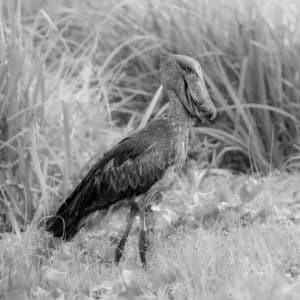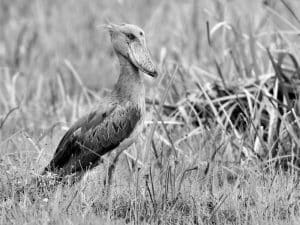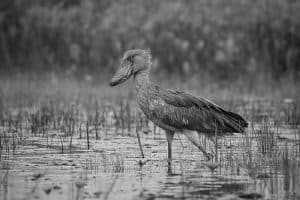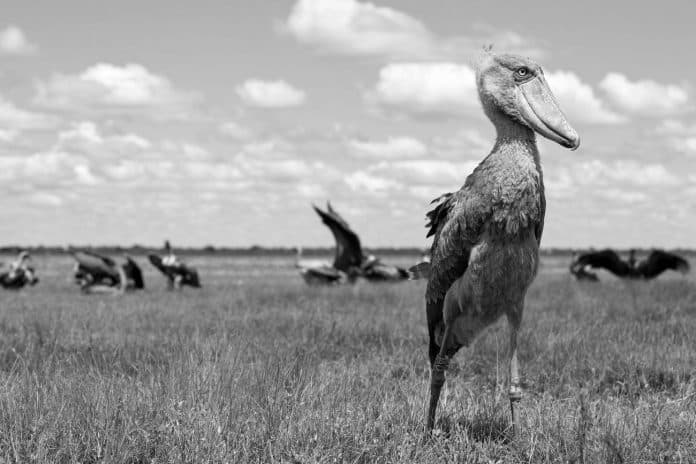Introducing the Shoebill: Tanzania’s Unique Avian Resident
Tanzania is home to a remarkable avian species that has captivated the hearts of bird enthusiasts and nature lovers worldwide – the magnificent Shoebill. Also known as the Whalehead or the Shoe-billed Stork, this extraordinary bird is a true wonder of the wetlands. With its prehistoric appearance and fascinating behaviors, the Shoebill in Tanzania stands as a testament to the diverse and mesmerizing wildlife that thrives in Tanzania’s rich ecosystems.

The Shoebill (Balaeniceps rex) is a large, uniquely shaped bird characterized by its massive shoe-shaped bill, towering height, and piercing gaze. Its distinct features set it apart as one of the most iconic and enigmatic avian residents of Tanzania. The bird’s name, “Shoebill,” is derived from the shape of its bill, which resembles an oversized Dutch clog, adding to its mystique and allure.
In addition to its striking physical attributes, the Shoebill possesses a remarkable set of behaviors and adaptations that make it a truly captivating subject of study and observation. From its solitary nature to its stealthy hunting techniques, the Shoebill’s lifestyle is shrouded in mystery, drawing inquisitive minds to seek out its presence in the wild wetlands of Tanzania.
The Natural Habitat of the Shoebill in Tanzania
Tanzania’s wetlands serve as the primary stronghold for the Shoebill, providing a vital and thriving habitat for these magnificent birds. The extensive network of marshes, swamps, and papyrus-fringed lakes in Tanzania offers the ideal setting for the Shoebill’s foraging and nesting activities. These unique wetland ecosystems provide a rich and diverse array of flora and fauna, sustaining the Shoebill and contributing to the overall biodiversity of the region.
The Rufiji River Basin, including the vast Selous Game Reserve, stands out as a prominent habitat for the Shoebill, offering expansive wetland areas where these birds can thrive. The abundance of water channels and reed beds in this region creates a perfect environment for the Shoebill to inhabit and fulfill its ecological role as a top predator in the wetland food web.
Moreover, the Udzungwa Mountains and Kilombero Valley wetlands further enhance the Shoebill’s habitat range, showcasing the interconnectedness of Tanzania’s diverse landscapes in supporting the survival and prosperity of this remarkable avian species.
Conservation Efforts for the Shoebill in Tanzania
As the Shoebill faces various threats, including habitat loss, human disturbance, and illegal trade, dedicated conservation efforts have been initiated to safeguard the future of these iconic birds in Tanzania. Conservation organizations and wildlife authorities have been actively involved in monitoring and protecting the Shoebill populations, striving to mitigate the factors that pose risks to their well-being.
In collaboration with local communities and stakeholders, conservation initiatives focus on habitat preservation, anti-poaching measures, and public awareness campaigns to promote the conservation of the Shoebill and its wetland environment. By engaging in research, habitat restoration, and community-based conservation programs, these efforts aim to secure a sustainable future for the Shoebill in Tanzania while fostering harmony between human activities and the natural habitats of these extraordinary birds.
Furthermore, the enforcement of legal protections and the establishment of designated conservation areas contribute to the overarching goal of ensuring the continued existence of the Shoebill as an integral component of Tanzania’s natural heritage.
The Significance of Shoebills in Tanzanian Culture and Ecosystem

The Shoebill holds a special place in Tanzanian culture, folklore, and traditional beliefs, reflecting its profound significance within the country’s cultural heritage. Revered as a symbol of strength, resilience, and natural balance, the Shoebill is celebrated in local stories, art, and rituals, embodying the interconnectedness between humans and the diverse wildlife that inhabits Tanzania’s wetlands.
Moreover, the presence of Shoebills in Tanzania’s ecosystems contributes to the ecological equilibrium of the region, playing a crucial role in regulating wetland populations and maintaining the delicate balance of the natural environment. Through their influence on prey species and wetland dynamics, Shoebills contribute to the overall health and sustainability of the wetland ecosystems in Tanzania, underscoring their intrinsic value beyond their captivating appearance.
Best Places for Shoebill Watching in Tanzania
For avid birdwatchers and nature enthusiasts seeking to witness the majestic Shoebill in its natural habitat, Tanzania offers a selection of prime locations renowned for Shoebill sightings. The sprawling wetlands and diverse landscapes of Tanzania provide unique opportunities to observe and appreciate the awe-inspiring presence of these remarkable birds.
The Selous Game Reserve stands out as a premier destination for Shoebill watching, offering expansive wetland areas and riverine habitats where these birds are commonly spotted. The network of lakes, channels, and marshes within the reserve provides an ideal setting for encountering Shoebills in their natural element, allowing visitors to witness their remarkable behaviors and interactions with the surrounding environment.
In addition to the Selous Game Reserve, the wetlands of the Kilombero Valley and the Udzungwa Mountains serve as prominent hotspots for Shoebill sightings, providing diverse and picturesque landscapes for immersive birdwatching experiences. These biodiverse regions offer a blend of wetland ecosystems, forests, and waterways, creating a rich tapestry of natural settings where Shoebills thrive and captivate the imagination of visitors.
Birdwatching Tips for Spotting Shoebills in Tanzania
When embarking on a Shoebill-watching expedition in Tanzania, employing effective birdwatching techniques and adopting a respectful approach to wildlife observation are essential for enhancing the experience and optimizing the chances of encountering these magnificent birds. By adhering to best practices and considering the behaviors and habits of Shoebills, visitors can elevate their birdwatching endeavors and foster a deeper connection with the natural world.
Patience and attentiveness are key virtues when seeking out Shoebills in their natural habitat. Given the solitary nature and stealthy tendencies of these birds, investing time in scouting potential habitats and observing their surroundings with keen observation can lead to rewarding encounters with Shoebills in the wild.
Utilizing binoculars or spotting scopes can significantly enhance the birdwatching experience, allowing for close-up views of Shoebills from a respectful distance while minimizing disturbance to their natural behaviors. Additionally, seeking guidance from knowledgeable local guides or wildlife experts can provide valuable insights and increase the likelihood of successful Shoebill sightings, enriching the overall birdwatching adventure in Tanzania.
The Fascinating Behavior and Diet of Shoebills in Tanzania
The Shoebill’s behavior and dietary preferences offer a captivating glimpse into the intricate ecological dynamics of Tanzania’s wetland ecosystems. Renowned for their patient and stealthy hunting tactics, Shoebills exhibit a fascinating array of behaviors that showcase their adaptability and prowess as top predators within their natural environment.
These birds are known for their characteristic ambush hunting style, where they patiently wait in shallow water among vegetation, poised to strike at unsuspecting prey. Shoebills primarily feed on a diverse range of aquatic creatures, including fish, amphibians, reptiles, and even small mammals, demonstrating their role as versatile and opportunistic hunters within the wetland food chain.
The Shoebill’s specialized bill serves as a formidable tool for capturing and consuming its prey, showcasing the bird’s exceptional adaptation to its hunting niche. With remarkable precision and power, Shoebills utilize their massive bills to grasp, impale, and swallow their catch, underscoring their unique feeding strategies and the evolutionary mastery of their ecological niche.
Protecting the Shoebill’s Habitat: Sustainable Tourism and Environmental Concerns

As the allure of Shoebill-watching continues to attract visitors to Tanzania’s wetlands, the imperative of promoting sustainable tourism practices and environmental stewardship becomes increasingly vital in safeguarding the habitats and well-being of these remarkable birds. Balancing the interests of ecotourism with the conservation of Shoebill habitats is paramount in ensuring the enduring legacy of these iconic avian residents in Tanzania’s natural landscapes.
By embracing sustainable tourism principles and responsible travel behaviors, visitors can contribute to the preservation of Shoebill habitats and the overall ecological integrity of the wetlands. Respecting designated wildlife viewing areas, minimizing disturbances to nesting sites, and supporting local conservation initiatives through ecotourism activities are essential steps in fostering a harmonious coexistence between tourism and the protection of Shoebills and their habitats.
Furthermore, raising awareness about the importance of conserving wetland ecosystems and promoting environmental education initiatives can inspire a collective commitment to safeguarding the natural heritage of Tanzania, including the invaluable habitats that sustain the Shoebill and other indigenous wildlife species.
Capturing the Shoebill: Photography and Artistic Inspiration
For photographers, artists, and creative individuals, the enchanting presence of the Shoebill offers a wealth of inspiration and visual allure. The iconic silhouette, intricate plumage, and captivating behaviors of the Shoebill provide a compelling subject for artistic expression and creative exploration, inviting enthusiasts to capture the essence of these extraordinary birds through various mediums and artistic endeavors.
Photographers seeking to immortalize the beauty of Shoebills in their natural habitat can hone their skills in wildlife photography, utilizing light, composition, and timing to convey the essence of these birds in stunning visual narratives. From close-up portraits that showcase the intricate details of the Shoebill’s bill and plumage to sweeping landscapes that frame their presence within the wetland environment, photographers can evoke the captivating allure of Shoebills through their artistry and technical expertise.
Similarly, artists and illustrators can find inspiration in the unique form and character of Shoebills, translating their impressions of these magnificent birds into evocative works of art that celebrate the enchanting essence of the avian world. Whether through paintings, sketches, or digital renderings, artists can convey the majesty and charm of Shoebills, inviting audiences to immerse themselves in the captivating beauty of these iconic avian residents of Tanzania.
Conclusion: Preserving Tanzania’s Shoebill Legacy
In conclusion, the Shoebill stands as a testament to the captivating diversity and ecological richness of Tanzania’s wetlands, captivating the imagination of all who encounter its majestic presence. As stewards of the natural world, it is our collective responsibility to preserve the legacy of the Shoebill and safeguard the habitats that sustain these remarkable birds for generations to come.
By embracing conservation efforts, responsible tourism practices, and a deep appreciation for the cultural and ecological significance of Shoebills, we can contribute to the enduring vitality of Tanzania’s wetland ecosystems and ensure the continued prosperity of these iconic avian residents. Through our dedication to environmental stewardship and the preservation of Shoebill habitats, we can uphold the enchanting legacy of these magnificent birds and celebrate their intrinsic value within the natural heritage of Tanzania. Let us join hands in preserving the Shoebill’s legacy and nurturing a harmonious coexistence between humanity and the captivating wildlife that graces Tanzania’s wetlands.

































